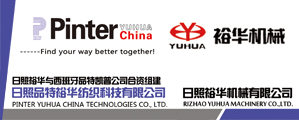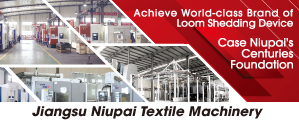Cotton Textile industry: abandoning the volume-biased production and focusing on high-end route
Jan 29, 2016 | by
Cotton Textile industry: abandoning the volume-biased production and focusing on high-end route
Interview with Ye Jianchun, vice president of China Cotton Textile Association
By Xu Yuanyuan

If you want to make a list of difficulty-ridden industrial manufacturing sectors in various fields in China, the whole textile industry cannot be in the column, but its cotton textile sector must be in the list.
It comes as no news at all in the whole textile industry that its cotton textile sector is running in difficulty, as is handicapped by the three years of cotton purchase and reserve policy, domestic and international price gap for thousands of RMB and the headache for over ten millions of the state reserve cotton in the warehouse that has no cure as of today. The cotton textile industry wriggles in painful course as a result of policy change, leading to various predicaments in mill operations during the 12thFive Year Program period.
Now all the people who work in the textile industry have such a question in mind: in face of the increasingly severe international competition, what is the core competitiveness of the China’s cotton textile industry? Recently, our reporter has an exclusive interview with Ye Jianchun, vice president of China Cotton Textile Association, discussing the present operation situation of Chinese cotton textile industry, the existing principal contradiction and the comprehensive competitiveness.
The biggest challenge: the supply of high quality cotton is hard to meet the needs from the high-end market
Today’s China cotton textile industry operates with difficulties for weak demand, said present Ye. Since the financial crisis in 2008, the international market has not improved significantly. With the coming of the “new normal”, the economic downward pressure caused external and internal troubles for the development of the whole textile industry as well as cotton textile industry.
Apart from the weak demand, the cotton textile industry is also faced with the raw material structure of its own, said president Ye, who also told the reporter that it’s very hard for the enterprises to find the cotton with high quality and meet the production requirements in the Chinese cotton spot market.
It is well known that the three-year cotton storage policy has brought great harm to the Chinese cotton textile industrial chain. Several thousand yuan of price difference between home and abroad made the enterprise shuffle under cost pressure. At present, the non-cotton spinning enterprises operate better than the cotton yarn spinners, so many enterprises steered their way to the non-cotton products in order to maintain production.
President Ye told the reporter that the blended yarn has become the main variety of enterprise production, and the main reason for this phenomenon is that it’s very hard for the enterprises to find the cotton with high quality and produce the competitive cotton yarn.
Besides, the impact of importing yarn is the main reason to influence the enterprises to adjust their product structure. China has tariff at only 5% of the imported yarn in value term without quota restrictions, making the cheap cotton yarn flood into China. In 2014, the economic operation report released by China Cotton Textile Association showed that the total amount of imported cotton yarn is 2.01 million tons and decreased by 4.2% year-on-year. The drop in growth rate cannot possibly overshadow its absolute volume of China’s yarn import which comes largely from Pakistan and India, the latter represents a sharp increase to 26% in 2014 from its11% market share in 2010. In addition, Vietnam also showed a trend of rapid growth of exporting cotton yarn to China, enjoying an increase from 10% in 2010 to 20% in 2014 of China’s total yarn import, basically closing to India-Pakistan cotton yarn in the cake-share.
In the first quarter of 2015, the importing yarn is as hot as previous years. The economic operation report pointed out that China imported 590,000 tons of cotton yarn and increased by 15.2% year-on-year while the cotton yarn export came merely around 90,000 tons and decreased by 24.5% year-on-year. President Ye told the reporter that the importing yarn will break through 2 million tons in the light of this trend. He also said that the China cotton industry will not pursue the path of scale development and will adhere to the industrial upgrading path, so the industry has to change to the climate of national policy and market competition.
The biggest expectation: cultivating “the machine picks cottons” in Xinjiang (or Sinkiang) for solving the raw material problem
President Ye told the reporter that there are some history reasons for lacking high quality cotton in Sinkiang in spite of the fact that the quality of cottons in Sinkiang is much higher than that of American cotton and Australian cotton in the past. The problem is that we have been too much focused on volume priority as our cotton industry policy guidance for many years; therefore, we gradually lost the quality advantage.
Now Sinkiang is the main producing area to produce cotton in China and accounts for two thirds of the total output. The entire output of cotton is about 5.5 million tons in 2015 with 4 million tons produced in Sinkiang and 1 million tons produced in inland. Said president Ye, who also told the reporter that the main reason that influence the quality of cotton in Sinkiang is the cotton seed.
Although the cotton textile enterprises have been calling for the quota-free import in recent years, little progress has been made for protecting the cotton growers. The free import without quotas will be easy to come to fulfillment if cotton quality is improving, empowering us with quality strength to participate in the international competition. President Ye also said that according to the current global cotton supply pattern, if China improved the quality of cotton to have the power to rival with American cotton and Australian cotton, then domestic enterprises’ demand for cotton will be satisfied and also can be exported. The biggest market of spinning is China, Southeast Asia and other neighboring countries, so we have the absolute geographical advantage for exporting cottons. Therefore, the global cotton market is bound to have a dramatic change in the future if China can achieve the goal of improving the cotton quality.
However, the upcoming two years is still the most difficult period for China cotton textile industry with the bad market situation, insufficient cotton supply and quota without liberalization, which will make a huge impact for the competition of China cotton textile industry.
The biggest advantage: a complete industrial chain, the progress of the equipment manufacturing industry, talent backups
China cotton textile industry struggled to survive and has huge operating pressure for facing the weak market demand externally and confronting the rising production cost, especially labor cost internally under difficult conditions of the raw material structure. We have to admit that the orders are placed in Southeast Asia in an increasing momentum, which is a very serious problem, especially the production of the low end cotton yarn and cloth for the reasons that enterprises couldn’t change. Said president Ye, who also told the reporter that many high-end brands choose to stay in China to process primarily for the mature industrial chain, steady quality and after-sales service compared with Southeast Asia countries, what’s more, China remains the strongest comprehensive strength.
President Ye pointed out that the industrial chain in China is very complete, which is a big advantage that other Southeast Asia countries can’t compete. If there is no complete industrial chain, it is very hard to have a rapid response to adapt to the new development for the small batch and many varieties of the customer needs.
President Ye told the reporter that Southeast Asia countries still have a big gap with China in dyeing and printing, after treatment technologies and they still need to import. This will inevitably lead to the failure in improving the added values; so many high-end brands enterprises choose China as processing base.
At present, the Chinese equipment manufacturing industry develops very fast thanks to the improvement of the technical equipment and quality promotion. President Ye introduced that the labor productivity has improved more significantly than before owning to the advanced digital and intelligent production line now in operation in China cotton textile industry. The production capacity of domestic textile machinery enterprises can satisfy the cotton textile enterprises’ needs in the full-packaged supply from the blowing-carding to the roving-spinning-winding combination line. However, there is still much room for improvement on the side of domestic textile machinery suppliers, compared with the foreign textile machinery manufacturers in terms of leading the market, researching and developing products in customer-conscious manner.
The foreign textile machinery enterprises, like Rieter, have a stronger research capability in the spinning process than the Chinese textile machinery enterprises do. They will not market equipments to the clients or have a try in cotton textile enterprises unless the equipments are matured. They will not only tell the enterprises how to use the machines but also guide the enterprises to go to the market if domestic cotton textile enterprises buy their equipments.
This business model and management concept adopted by foreign companies are different from what the Chinese textile machinery enterprises do in that the Chinese companies are generally waiting to respond to the feedbacks of the problems that happen to the equipment in client’s mill operation, short of service awareness, spinning theory or mechanism. What is the real service and how to provide a better service etc.. President Ye also expressed that the ascension of the textile machinery quality emblems the promotion of the whole industries’ level, which cannot be done in a short time. After all, the foreign textile machinery enterprises have several hundred years of history that provides a fundamentally time-honored strength, posing a hard challenge to the Chinese textile machinery manufacturers with a short history in machinery building. It should be certain that the Chinese textile machinery enterprises developed very fast in recent two years, especially for the promotion of the equipment quality, talent backups, which have changed a lot more significantly than ever before.
President Ye said that the cotton textile technology will move towards automation, high speed, intelligence, and information-based development for the future technical trend of the industry.
The cotton yield in China
Year 2011/2012:6.6 million tons,
Year 2012/2013: 7.3 million tons,
Year 2013/2014:7.5 million tons,
Year 2014/2015:6.5 million tons,
Year 2015/2016:5.5 million tons
The cotton price gap at home and abroad (average value)
Year 2011:-1346 yuan/ton
Year 2012: 4955 yuan/ton
Year 2013:5260 yuan/ton
Year 2014:4018 yuan/ton
The amount of the imported yarn
Year 2010: 1.11 mt
Year 2011: 0.9 mt
Year 2012:1.53 mt
Year 2013:2.10 mt
Year 2014: 2.01 mt
The amount of the imported cotton
Year 2010: 2.83 mt
Year 2011: 3.36 mt
Year 2012: 5.13mt
Year 2013: 4.15 mt
Year 2014: 2.44 mt
The progress of equipment and technology (share of total)
The automatic winder:
Year 2010: 61.69%
Year 2014: 72.1%
The shuttleless loom:
Year 2010: 58.75%
Year 2014: 61.5%
Spinning frame (long frame):
Year 2010: 4.7 million spindles
Year 2014: 17.84 million spindles
Compact spinning:
Year 2010: 7.2 million spindles
Year 2014: 17.83 million spindles








